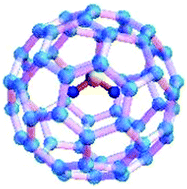Interactions between a water molecule and C60 in the endohedral fullerene H2O@C60†
Abstract
A water molecule encapsulated inside a C60 fullerene cage behaves almost like an asymmetric top rotor, as would be expected of an isolated water molecule. However, inelastic neutron scattering (INS) experiments show evidence of interactions between the water molecule and its environment [Goh et al., Phys. Chem. Chem. Phys., 2014, 16, 21330]. In particular, a resolved splitting of the 101 rotational level into a singlet and a doublet indicates that the water molecule experiences an environment of lower symmetry than the icosahedral symmetry of a C60 cage. Recent calculations have shown that the splitting can be explained in terms of electrostatic quadrupolar interactions between the water molecule and the electron clouds of nearest-neighbour C60 molecules, which results in an effective environment of S6 symmetry [Felker et al., Phys. Chem. Chem. Phys., 2017, 19, 31274 and Bačić et al., Faraday Discussions, 2018, 212, 547–567]. We use symmetry arguments to obtain a simple algebraic expression, expressed in terms of a linear combination of products of translational and rotational basis functions, that describes the effect on a water molecule of any potential of S6 symmetry. We show that we can reproduce the results of the electrostatic interaction model up to ≈12 meV in terms of two unknown parameters only. The resulting potential is in a form that can readily be used in future calculations, without needing to use density functional theory (DFT) for example. Adjusting parameters in our potential would help identify whether other symmetry-lowering interactions are also present if experimental results that resolve splittings in higher-energy rotational levels are obtained in the future. As another application of our model, we show that the results of DFT calculations of the variation in energy as a water molecule moves inside the cage of an isolated C60 molecule, where the water molecule experiences an environment of icosahedral symmetry, can also be reproduced using our model.



 Please wait while we load your content...
Please wait while we load your content...